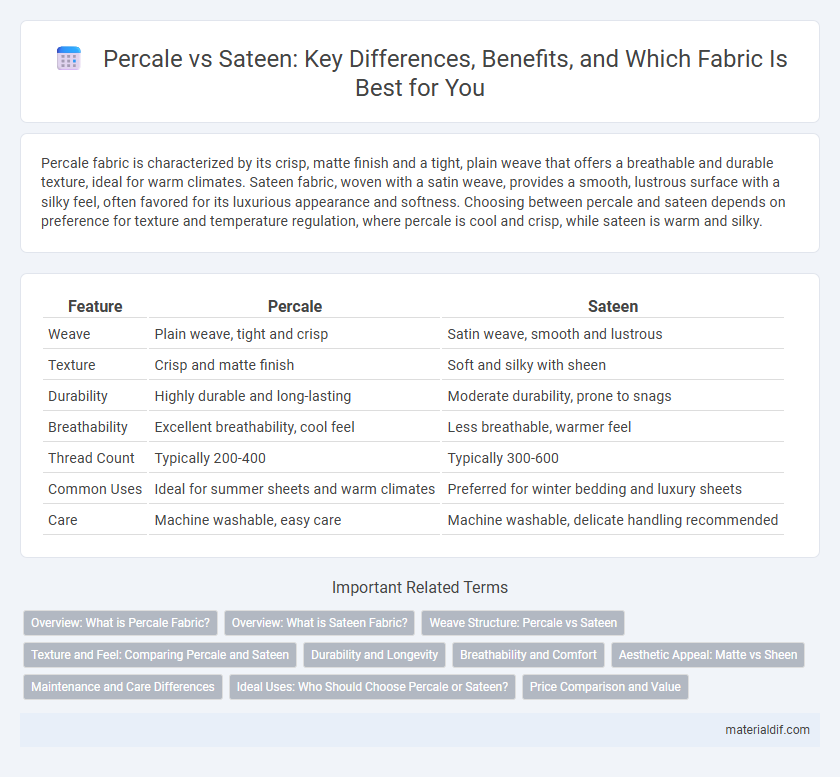Percale fabric is characterized by its crisp, matte finish and a tight, plain weave that offers a breathable and durable texture, ideal for warm climates. Sateen fabric, woven with a satin weave, provides a smooth, lustrous surface with a silky feel, often favored for its luxurious appearance and softness. Choosing between percale and sateen depends on preference for texture and temperature regulation, where percale is cool and crisp, while sateen is warm and silky.
Table of Comparison
| Feature | Percale | Sateen |
|---|---|---|
| Weave | Plain weave, tight and crisp | Satin weave, smooth and lustrous |
| Texture | Crisp and matte finish | Soft and silky with sheen |
| Durability | Highly durable and long-lasting | Moderate durability, prone to snags |
| Breathability | Excellent breathability, cool feel | Less breathable, warmer feel |
| Thread Count | Typically 200-400 | Typically 300-600 |
| Common Uses | Ideal for summer sheets and warm climates | Preferred for winter bedding and luxury sheets |
| Care | Machine washable, easy care | Machine washable, delicate handling recommended |
Overview: What is Percale Fabric?
Percale fabric is a tightly woven plain-weave textile known for its crisp, matte finish and durability. Typically made from cotton or a cotton blend, percale features a high thread count, usually above 180, ensuring breathability and a cool, smooth texture ideal for bedding. Its lightweight, matte surface contrasts with sateen's sheen, making percale a preferred choice for those seeking a fresh, crisp feel.
Overview: What is Sateen Fabric?
Sateen fabric is a type of cotton material distinguished by its satin weave, producing a smooth, lustrous surface with a subtle sheen. Unlike percale, which has a matte finish and a crisp texture, sateen features a softer and silkier feel, making it ideal for luxury bedding. The weave structure of sateen creates a denser, heavier fabric that drapes elegantly and offers enhanced warmth and comfort.
Weave Structure: Percale vs Sateen
Percale fabric features a plain weave structure with a one-over, one-under pattern, creating a crisp and breathable texture ideal for warm climates. Sateen fabric utilizes a satin weave, typically a four-over, one-under pattern, resulting in a smooth, lustrous surface with a silky feel but reduced airflow. The distinct weave structures of percale and sateen significantly impact durability, texture, and breathability in bedding and apparel applications.
Texture and Feel: Comparing Percale and Sateen
Percale fabric offers a crisp, lightweight texture with a matte finish known for its breathable and cool feel, ideal for warm climates and those who prefer a fresh, smooth surface. Sateen, composed of a denser weave with longer yarn floats, provides a silky, lustrous texture that feels soft and luxurious against the skin, making it perfect for cooler seasons or individuals seeking a plush touch. Both fabrics use cotton fibers but differ significantly in their weave structure, resulting in distinct tactile experiences that cater to various preferences in bedding comfort.
Durability and Longevity
Percale fabric is woven with a tight, plain weave that enhances its durability and makes it resistant to wear and tear over time. Sateen, with its satin weave, offers a softer and silkier texture but is more prone to snagging and may wear out faster under frequent use. For long-lasting bedding, percale is preferred due to its strength and ability to maintain crispness after multiple washes.
Breathability and Comfort
Percale fabric features a tight plain weave with a matte finish, offering superior breathability and a crisp, cool feel ideal for warm climates. Sateen fabric has a satin weave that creates a smooth, lustrous surface, providing a softer touch but less airflow, which can trap heat. Breathability and comfort in percale make it a preferred choice for those who sleep hot, while sateen suits individuals seeking a silky texture and warmer warmth.
Aesthetic Appeal: Matte vs Sheen
Percale fabric offers a crisp, matte finish that enhances a clean and understated aesthetic, often preferred for its vintage charm and airy feel. Sateen fabric features a smooth, lustrous sheen due to its satin weave, creating a luxurious, glossy appearance that reflects light beautifully. The choice between percale and sateen significantly impacts bedroom ambiance, with percale providing a subtle, muted look while sateen delivers a rich, elegant shine.
Maintenance and Care Differences
Percale fabric, made from tightly woven cotton with a matte finish, requires regular washing in cool or warm water and benefits from low heat drying to prevent shrinkage and maintain its crisp texture. Sateen, characterized by its smooth, glossy surface due to a satin weave, demands gentler care such as washing in cold water and air drying or tumble drying on low to preserve its sheen and softness. Both fabrics should be ironed on appropriate settings, with percale tolerating higher heat and sateen needing lower temperatures to avoid damage.
Ideal Uses: Who Should Choose Percale or Sateen?
Percale fabric, known for its crisp, matte finish and breathable weave, is ideal for hot sleepers and those who prefer a lightweight, durable sheet that softens with each wash. Sateen fabric, with its smooth, lustrous surface and heavier weight, suits individuals seeking a silky, warm feel perfect for cooler climates or a luxurious bedroom aesthetic. Homeowners and hospitality industries prioritize percale for everyday durability and breathability, while sateen appeals to those desiring an elegant, satin-like texture for special occasions or premium bedding.
Price Comparison and Value
Percale fabric typically offers a more affordable price point compared to sateen, making it an economical choice for budget-conscious shoppers. Sateen, with its silkier finish and higher thread count, commands a premium price but provides enhanced softness and durability. For long-term value, percale balances cost and breathability, while sateen delivers luxury and a smoother feel, justifying its higher investment for those prioritizing comfort.
Percale vs Sateen Infographic

 materialdif.com
materialdif.com